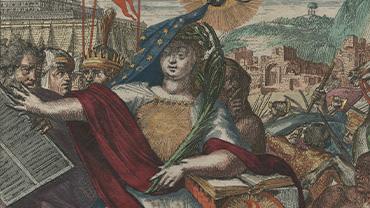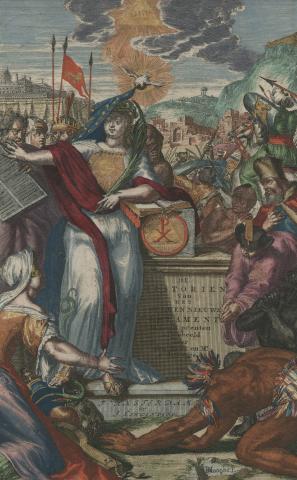
The artwork I chose to analyze is Romeyn de Hooghe’s “History of the Old and New Testament” from the Barlev-Halperin collection of maps of the Holy Land. De Hooghe (1645-1708) was a Dutch engraver, sculptor, and painter. He is known for his caricatures of famous political figures of his time, particularly Louis XIV, though he completed thousands of illustrations and prints for various books and texts. This piece may be a cover page for a Bible or series of biblically inspired illustrations. However, it is also a commentary on Dutch Golden Age attitudes towards European expansion and conquest, and I’ll endeavor to point out as many examples as I can.

The illustration draws a direct parallel between Christianity and European imperialism, and ponders a future in which the former can exist without the latter. However, the overlapping scenes center European history as global history, and the piece’s function as a religious object limits the reach of its critique. The central figure is the classical portrayal of Lady Justice, inscribed with a scale on her golden breastplate. She carries an olive frond in her left hand, with a crown of olive branches encircling her head. Her toga is white, and her stole is Roman red. She steps on a snake reaching for a fruit that lies above a globe, alluding to Eve’s original sin. A skull and a wooden paddle lie next to it. Lady Justice partially sits on the platform that bears the titular monument, and rests her left arm atop an open book on the Chi-Rho, two Greek symbols representing the first letters of Christ which were politically adopted by the emperor Constantine the Great.
Justice is honored with the dove of the Holy Spirit, covering her in a blanket of stars. The dove is bathed in gold, and a glowing golden triangle parts the clouds. The triangle is inscribed with the ancient Hebrew characters for INRI – IESVS NAZARENVS REX IVDAEVORVM – meaning “Jesus of Nazareth, King of the Jews.” This is a famous biblical quotation that according to the Gospel of John, was inscribed above Christ’s head when he was crucified. It has also taken political and imperial meaning, as justification for the European invasion of the Middle East and Muslim world in the name of bringing non-Christians, considered lost souls, to Christianity. This message is evident in the characters that surround Lady Justice.
To Lady Justice’s left (on the right-hand side of the page), soldiers on foot and on horseback charge into war, headed for the ruins. An ark, reminiscent of Noah’s in Genesis, sits upon the highest hill to the far left. The soldiers’ uniforms and weapons are emblazoned with golden lions and sphinxes, calling to the Venetian flag, the Byzantine and Roman flags, as well as later valiants like Richard I and William the Conqueror. Pan-European unity is proudly on display, which is curious.
De Hooghe’s Justice then draws specifically from Christianity, and she is called upon to arbitrate the fate of the African, Asian, Native American, and Islander peoples facing European imperialism. De Hooghe implicates himself here. He creates the notion of a unified Europe by contrasting the glory of empire with the impoverishment of the oppressed. This is made starkly clear through the care, attention to detail, and diversity of emotions and functions of the European characters in the scene versus the animalistic expressions, rudimentary dress, and body position of the colonial subjects. Even within the paint used for skin, de Hooghe’s Europeans shine with complex undertones while the colonial subjects are stereotypically painted with basic race-based coloring – jet black, red, and yellow. For de Hooghe, Europe exists in juxtaposition to the rest of the world. He imbues it with the religious justification and power of the Bible, accurately depicting it as a tool of imperialism and colonialism that heightens Europe’s wealth and hypocrisy. His efforts to criticize colonialism fall flat because he venerates the very dressings that allow it to function. Therefore, though initially she seems impartial, a closer inspection of the piece reveals that Lady Justice is not only woefully inadequate in her role, but that she serves as the primary agent and abetter of European imperialism.
Christianity and colonialism, along with capitalism, go hand in hand. The scene to Lady Justice’s right displays the wealth and riches of European kings and rulers throughout various time periods through their dress. An accountant gestures to her to present his findings, and behind them a pristine city sits high upon a hill with tall stone fortifications. Lady Justice focuses her attention on the young European female petitioner who pleads on behalf of the colonial subjects. None of the subjects speak for themselves nor lift their gaze. They are secondary observers in the case for their very lives, and are not portrayed as capable of advocating for themselves. Again here de Hooghe reveals his own and society’s prejudices through this interaction.
To the center, right over Lady Justice’s left shoulder, stands a figure shrouded in darkness, with a finger of silence to their lips. They have no discernable features – not race, gender, or garment to indicate who they represent. Ruins of a city lie in the background, with green rolling hills behind. This figure can be interpreted in a myriad of ways – from an improbable Satanic figure influencing Lady Justice, a prophet predicting the ruin of European states to infighting if they do not go forth and conquer other peoples, or a guilty conscience staring at the viewer that refuses to relinquish their benefits despite the direct harm caused to others.
I’m not as struck by what the figure might be saying, though likely a combination of all three suppositions and more, as how they are represented. This is the only figure directly interacting with the viewer. Yet amidst brilliant gold and deep colors, they are awash in gray silence. De Hooghe’s reluctance to voice these oppositions contradict his renowned recalcitrance. His outspokenness on the misuse of authority does not extend to include the role he plays. Like the young lady who presumes to speak for those purposefully rendered mute, de Hooghe does not see himself as a co-abetter to European colonialism. As a consequence, though he wishes to ponder a global future beyond colonialism, his inability to extricate global history and narrative drive from European – and his own – hands paints a fantastically cyclical mirage.
-Joella Kiondo, C’2026
